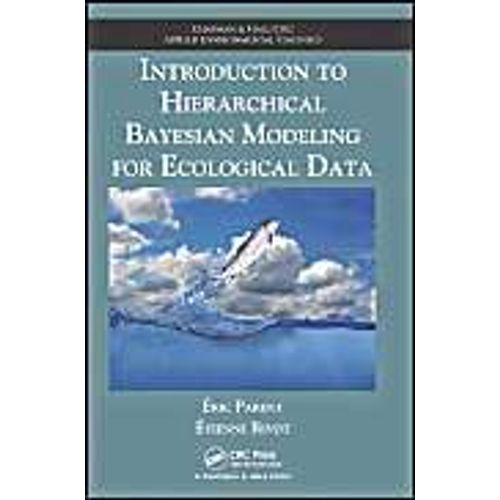

Introduction to Hierarchical Bayesian Modeling for Ecological Data - Parent, Eric
- Format: Relié
- 428.0 pages Voir le descriptif
Vous en avez un à vendre ?
Vendez-le-vôtre44,61 €
Produit Neuf
Ou 11,15 € /mois
- Livraison à 0,01 €
- Livré entre le 4 et le 7 août
- Payez directement sur Rakuten (CB, PayPal, 4xCB...)
- Récupérez le produit directement chez le vendeur
- Rakuten vous rembourse en cas de problème
Gratuit et sans engagement
Félicitations !
Nous sommes heureux de vous compter parmi nos membres du Club Rakuten !
TROUVER UN MAGASIN
Retour

Avis sur Introduction To Hierarchical Bayesian Modeling For Ecological Data Format Relié - Livre
0 avis sur Introduction To Hierarchical Bayesian Modeling For Ecological Data Format Relié - Livre
Donnez votre avis et cumulez 5
Les avis publiés font l'objet d'un contrôle automatisé de Rakuten.
Présentation Introduction To Hierarchical Bayesian Modeling For Ecological Data Format Relié
- LivreAuteur(s) : Parent, Eric - Rivot, EtienneEditeur : Chapman And Hall/CrcLangue : AnglaisParution : 01/08/2012Format : Moyen, de 350g à 1kgNombre de pages : 428.0Expédition : 711Dimensions :...

Résumé :
Bayesian statistics are becoming the contemporary standard for treating ecological data. This book is designed for readers who are interested in the quantitative analysis of environmental data yet reluctant to apply ready-made technical recipes without understanding how and why they work. It focuses on up-to-date ecological issues, including biodiversity, community behavior, and genomics, and shows how they could be revisited by using Bayesian modeling techniques. Highly practical, the text encourages readers to deal with advanced ecological issues in practice and to implement models of their own.
Biographie: ?ric Parent is head of the Research Laboratory for Risk Management in Environmental Sciences (Team MORSE) and a professor in applied statistics and probabilistic modeling for environmental engineering at the National Institute for Rural Engineering, Water and Forest Management (ENGREF/AgroParisTech) in Paris, France. Dr. Parent's research encompasses Bayesian theory and applications, with special emphasis on environmental systems modeling. ?tienne Rivot is a researcher in the Fisheries Ecology Laboratory at Agrocampus Ouest in Rennes, France. Dr. Rivot's research focuses on the application of Bayesian statistical modeling for the analysis of ecological data, inference, and predictions.
Sommaire:
I Basic Blocks of Bayesian Modeling Bayesian Hierarchical Models in Statistical Ecology Challenges for statistical ecology Conditional reasoning, graphs and hierarchical models Bayesian inferences on hierarchical models What can be found in this book? The Beta-Binomial Model From a scientific question to a Bayesian analysis What is modeling? Think conditionally and make a graphical representation Inference is the reverse way of thinking Expertise matters Encoding prior knowledge The conjugate Beta pdf Bayesian inference as statistical learning Bayesian inference as a statistical tool for prediction Asymptotic behavior of the beta-binomial model The beta-binomial model with WinBUGS Further references The Basic Normal Model Salmon farm's pollutants and juvenile growth A Normal model for the fish length Normal-gamma as conjugate models to encode expertise Inference by recourse to conjugate property Bibliographical notes Further material Working with More Than One Beta-Binomial Element Capture-mark-recapture analysis Successive removal analysis Testing a new tag for tuna Further references Combining Various Sources of Information Motivating example Stochastic model for salmon behavior Inference with WinBUGS Results Discussion and conclusions The Normal Linear Model The decrease of Thiof abundance in Senegal Linear model theory A linear model for Thiof abundance Further reading Nonlinear Models for Stock-Recruitment Analysis Stock-recruitment motivating example Searching for a SR model Which parameters? Changing the error term from lognormal to gamma From Ricker to Beverton and Holt Model choice with informative prior Conclusions and perspectives Getting beyond Regression Models Logistic and probit regressions Ordered probit model Discussion II More Elaborate Hierarchical Structures HBM I: Borrowing Strength from Similar Units Introduction HBM for capture-mark-recapture data Hierarchical stock-recruitment analysis Further Bayesian comments on exchangeability HBM II: Piling up Simple Layers HBM for successive removal data with habitat and year Electrofishing with successive removals HBM III: State-Space Modeling Introduction State-space modeling of a biomass production model State-space modeling of Atlantic salmon life cycle model A tool of choice for the ecological detective Decision and Planning Summary Introduction The See-Selune river network Salmon life cycle dynamics Long-term behavior: Collapse or equilibrium? Management reference points Management rules and implementation error Economic model Results Discussion Appendix A: The Normal and Linear Normal Model Appendix B: Computing Marginal Likelihoods Appendix C: The Baseball Players' Historical Example Appendix D: More on Ricker Stock-Recruitment Bibliography Index
Détails de conformité du produit
Personne responsable dans l'UE
